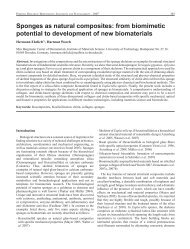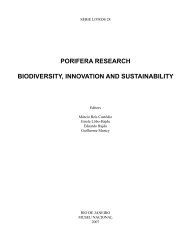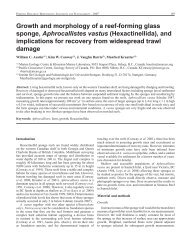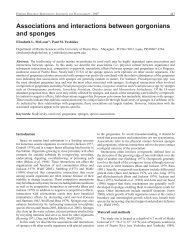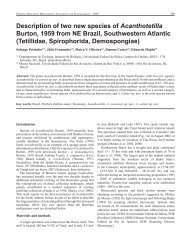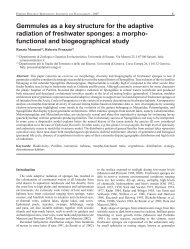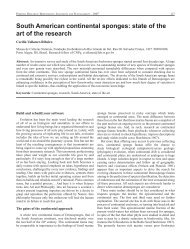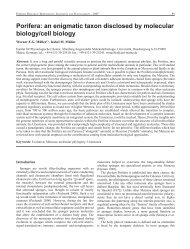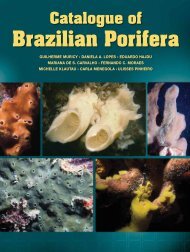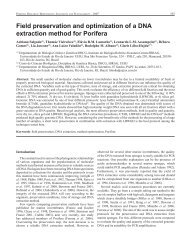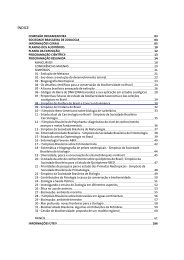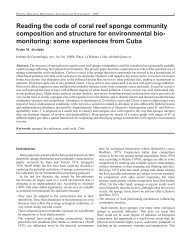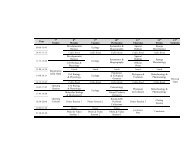Fossil sponges of Argentina: a review - Porifera Brasil
Fossil sponges of Argentina: a review - Porifera Brasil
Fossil sponges of Argentina: a review - Porifera Brasil
You also want an ePaper? Increase the reach of your titles
YUMPU automatically turns print PDFs into web optimized ePapers that Google loves.
<strong>Porifera</strong> Research: Biodiversity, Innovation and Sustainability - 200711<strong>Fossil</strong> <strong>sponges</strong> <strong>of</strong> <strong>Argentina</strong>: a <strong>review</strong>Matilde Sylvia BeresiCONICET-CRICYT: Ianigla, Dto. de Geología y Paleontología, Avda Ruiz Leal s/n, 5500 Mendoza, <strong>Argentina</strong>.mberesi@lab.cricyt.edu.arAbstract: This is a <strong>review</strong> on fossil <strong>sponges</strong> and sponge spicules reported from several regions in <strong>Argentina</strong> and in strataranging in age from Early Cambrian to Tertiary. Sponges have been collected from marine sediments <strong>of</strong> the Puna, CordilleraOriental and Sierras Subandinas basins, northern <strong>Argentina</strong>; Famatina Range; Precordillera terrane, San Rafael block,Neuquén basin and from lacustrine deposits <strong>of</strong> the North Patagonian Massif. Knowledge <strong>of</strong> the sponge fossil record is basedon whole relatively rigid skeletons, fragments <strong>of</strong> skeletal nets and spicules seen in thin sections or recovered from acetic acidresidues. Early to Middle Cambrian <strong>Porifera</strong> and Chancelloriids are known from the carbonate platform and slope facies<strong>of</strong> the Precordillera terrane. Specimens with body preservation <strong>of</strong> Protospongia, Diagoniella, Kiwetinokia, fragments <strong>of</strong>hexactinellid, and anthaspidellid <strong>sponges</strong> and sclerites <strong>of</strong> Chancelloria had been reported from Cambrian <strong>of</strong> the Precordillera.Remains <strong>of</strong> hexactinellid <strong>sponges</strong>, Pelicaspongiidae and Protospongiidae, have been found in Ordovician rocks <strong>of</strong> the Punaand <strong>of</strong> the Famatina System, western margin <strong>of</strong> Gondwana. Protospongia sp. and hexactinellid mesh were reported from UpperCambrian-Lower Ordovician siliciclastic sediments in the Cordillera Oriental and Sierras Subandinas. The most significantfossil record <strong>of</strong> Lower-Middle Ordovician sponge faunas is from the carbonate platform <strong>of</strong> the San Juan Precordillera. Spongefaunas are dominated by orchoclad lithistid demosponge genera, although hexactinellids are known from loose spicules androot tufts, and calcareous heteractinid <strong>sponges</strong> are known from isolated octactine spicules and only one genus. Hexactinellid,calcarean and demosponge spicules were reported from diverse localities <strong>of</strong> the Precordillera. A Late Jurassic (Oxfordian)carbonate complex <strong>of</strong> the Neuquén Basin, west-central <strong>Argentina</strong>, contains siliceous <strong>sponges</strong> dominated by hexactinellids(Hexactinosa and Lyssakinosa). Palaeospongilla chubutensis, a fresh water sponge, was described from lacustrine Cretaceousdeposits <strong>of</strong> the Chubut River valley. Oxeas and strongyles, belonging to the Family Spongillidae, have been mentioned fromTertiary sediments <strong>of</strong> the Paraná basin, northeastern <strong>Argentina</strong>.Keywords: biostratigraphy, fossil <strong>sponges</strong>, <strong>Argentina</strong>.IntroductionThe actual knowledge <strong>of</strong> the record fossil in <strong>Argentina</strong>is based on relatively rigid whole skeletons, fragments <strong>of</strong>skeletal nets and spicules seen in thin sections or recoveredfrom acid residues for obtaining conodonts. The fossilrecord <strong>of</strong> <strong>sponges</strong> comes from several geological provinces<strong>of</strong> <strong>Argentina</strong> with different lithologic, paleontologic andenvironmental characteristics.Sponge faunas were collected from marine sediments <strong>of</strong>the Puna, Cordillera Oriental, Sierras Subandinas basins <strong>of</strong>northern <strong>Argentina</strong>; Famatina Range, Precordillera Terrane,San Rafael Block, Neuquén Basin (western <strong>Argentina</strong>), fromlacustrine deposits <strong>of</strong> the North Patagonian Massif, and fromthe Chaco-Paranaense Basin. Occurrences <strong>of</strong> sponge faunashave been reported from the Lower Paleozoic (upper-LowerCambrian) to the Cenozoic (Tertiary). Only a few publicationshave dealt with sponge and sponge spicules in <strong>Argentina</strong>.Most <strong>of</strong> them concern the fauna from the Cambrian andOrdovician rocks <strong>of</strong> the Precordillera terrane.Associated with protospongiid spicules, well-preservedchancelloriid sclerites occur in the Cambrian carbonateplatform <strong>of</strong> the Precordillera. Chancelloriids are Cambrianenigmatic organisms constituting the monophyletic taxonCoeloscleritophora (Bengtson and Missarzhevsky 1981).Sclerites <strong>of</strong> chancelloriids (Family Chancelloridae) were firstdescribed from the Burgess Shale by Walcott (1920), whointerpreted them as heteractinid <strong>sponges</strong>. This traditionalview <strong>of</strong> the fossil group as <strong>sponges</strong> was accepted for morethan 50 years.In the Precordillera, chancelloriid sclerites associatedwith spicules are a common and distinguishing features <strong>of</strong>the Lower to Middle Cambrian fossil fauna. Protospongiaand Chancelloria crucensis (Rusconi, 1955) were the firstCambrian species <strong>of</strong> the Mendoza Precordillera.Cambrian Protospongia Salter, 1864 and hexactinellidspicules were mentioned by Pernas (1964), Devizia (1973),Bordonaro and Martos (1985), Heredia et al. (1987) andBeresi and Heredia (1995) from the San Isidro area inthe Precordillera <strong>of</strong> Mendoza. Afterwards, assemblagestentatively identified as Kiwetinokia utahensis Walcott, 1920,protospongiid skeletal nets and Chancelloria eros Walcott,1920 were reported from early-Middle Cambrian carbonatesblocks <strong>of</strong> San Juan and Mendoza, Precordillera, by Beresiand Rigby (1994). Two small associated specimens assignedto Protospongia sp. occur in the western Precordillera <strong>of</strong> San
12Juan (Beresi and Banchig 1997). A synthesis <strong>of</strong> the Cambriansponge occurrence in the Argentine Precordillera was givenby Beresi (2003a).Silicified sponge spicules from residues <strong>of</strong> conodonts fromdiverse Cambrian and Ordovician sections in the Precordillera,were described by Mehl and Lehnert (1997). Anthaspidellidskeletal fragments from the Middle Cambrian rocks <strong>of</strong> thePrecordillera, in the province <strong>of</strong> San Juan, document the onlyknown occurrence from South America (Beresi and Rigby1994). Protachileum kayseri Zittel, 1877 from the San Juanprovince, was the first report <strong>of</strong> a Precordilleran sponge.Taxonomic studies have been concentrated in the rich spongefauna <strong>of</strong> the warm carbonate platform (San Juan Formation)from the Lower-Middle Ordovician <strong>of</strong> the Precordillera basin(Beresi and Rigby 1993, Carrera 1996a, 1996b).The purpose <strong>of</strong> this paper is to <strong>review</strong> the occurrence <strong>of</strong>fossil <strong>sponges</strong> and their biostratigraphic distribution in thediverse geological provinces <strong>of</strong> <strong>Argentina</strong>.Cambrian and Ordovician fauna from theNorthwest Argentinian regionSiliciclastic sediments with minor carbonates dominatethe Cambrian and Ordovician <strong>of</strong> Northern <strong>Argentina</strong> andthe Central Andean Basin <strong>of</strong> South America. Cambrian andOrdovician <strong>sponges</strong> and spicules from Northwest <strong>Argentina</strong>provide additional paleontological data from the siliciclasticplatforms <strong>of</strong> western Gondwana.PunaIn the Puna region (Fig. 1A-B), a single specimen (Fig.2M-N) <strong>of</strong> a complete Ordovician hexactinellid sponge wasdiscovered. It has been collected from volcaniclastic rocks<strong>of</strong> the Las Vicuñas Formation (Tremadocian) in Lari Creek,southwest <strong>of</strong> the Salar del Rincon area, Salta province,<strong>Argentina</strong>. The material was assigned to the new genus andspecies Larispongia magdalenae (Carrera, 1998), that belongto the family Pelicaspongiidae, and it is the first record <strong>of</strong> thefamily in western Gondwana.Subandean RangesThe first report on the occurrence <strong>of</strong> one completelypreserved hexactinellid sponge is a part and counterpart <strong>of</strong> around small sponge described as Diagoniella sp. (Beresi et al.2006). This sponge (Fig. 2H) was reported for the first timefrom the Upper Cambrian-Lower Ordovician siliciclasticrocks <strong>of</strong> the Orcomato Formation, in the Candelaria Range,Sub-Andean Ranges, in Salta Province (Fig. 1B).The fossiliferous record <strong>of</strong> the unit suggests a Cambrian-Ordovician age. The sponge is preserved in greenishyellowishshales, as dark stained flattened rounded bodies(somewhat deformed and fragmentary).Fig. 1: A. South America showing the position <strong>of</strong> <strong>Argentina</strong>. B.Location <strong>of</strong> the Basins <strong>of</strong> <strong>Argentina</strong> with sponge fauna: (Pu) Puna;(CO) Cordillera Oriental, (SS) Sierras Subandinas, (F) Famatina,(Pa) Paraná basin, (P) Precordillera, (SR) San Rafael Block, (N)Neuquén basin, (MP) North Patagonian Massif. C. Map <strong>of</strong> Argentineshowing the San Juan and Mendoza provinces. D. Sponge localitieswithin the Precordillera Precordillera <strong>of</strong> San Juan and northernMendoza provinces.Eastern CordilleraHexactinellid meshes <strong>of</strong> Protospongia (Beresi et al. 2006)were recently reported from Lower Tremadocian siliciclasticsediments in the Eastern Cordillera, Salta Province (Fig. 1).The hexactinellid spicules were recovered from the lower
13Fig. 2: A. Cambrian anthaspidellidsponge fragment, genus andspecies indeterminant fromSan Isidro, Mendoza. B-G.Coeloscleritophora: Chancelloriaeros Walcott, 1920, scleritesfrom the upper Lower–MiddleCambrian <strong>of</strong> Zonda Range andSan Isidro area. H. Diagoniellasp. from Salta province, Sub-Andean ranges. I. Cambrianfragment <strong>of</strong> bioclastic limestoneshowing sclerites <strong>of</strong> ChancelloriaWalcott, 1920, San Isidro. J.Root tuft, large monaxons ormonactine-like spicules, in bundlewith small stauracts or hexacts(Tontal Range). K. Protospongiasp. showing stauractine-basedskeleton and long rayed hexactinesforming marginal spines alongthe left margin (Tontal Range).L. Protospongia sp. Esteban andRigby, 1998, specimen PIL 14.192from Peña Negra section, Famatinaregion. M-N. Larispongiamagdalenae Carrera, 1998,holotype CEGH-UNC 17365 fromLari Creek, Puna region. N. Detail<strong>of</strong> the same specimen showingdermal hexactines surroundingmajor gaps.levels <strong>of</strong> the Saladillo Formation, at the Angosto de laQuesera section, Eastern Cordillera.Spicules <strong>of</strong> Protospongia (Fig. 2K) are preserved on uppersurfaces <strong>of</strong> yellow-brownish shales and sandstones belongingto the lower section <strong>of</strong> the unit, sharing the stratigraphicposition with Tremadocian graptolites. The sedimentation<strong>of</strong> the greenish and yellowish shales and sandstones <strong>of</strong>the Saladillo Formation indicates a transition to an upper<strong>of</strong>fshore-lower <strong>of</strong>fshore environmental setting.Famatina systemCatamarca ProvinceThe only discovery <strong>of</strong> Ordovician <strong>sponges</strong> in thisprovince corresponds to isolated hexactinellid spicules,which have been described by Aceñolaza and Toselli (1977)for the Chaschuil region. The material appears dispersed incarbonate concretions <strong>of</strong> the Suri Formation (Arenig).La Rioja ProvinceThe sponge material came from black siliceous graptoliticshales <strong>of</strong> the upper part <strong>of</strong> the Volcancito Formation <strong>of</strong> LowerTremadocian age, outcropping in the Peña Negra locationin the Famatina range (Fig. 1B). Fragments <strong>of</strong> a reticulatedskeletal net <strong>of</strong> Protospongia species (A and B) were describedby Esteban and Rigby (1998), in the siliclastic Famatinabasin, western margin <strong>of</strong> Gondwana (Fig. 2L).The <strong>sponges</strong> are associated with planktonic graptolites andthis level can be assigned to the Lower Tremadoc (Estebanand Gutierrez-Marco 1997).
14Precordillera (Cuyania) Terrane, Western<strong>Argentina</strong>The Argentine Precordillera is situated along the forefront<strong>of</strong> the high Andes at approximately 28º to 37º S, and it isa major geologic province in northwestern <strong>Argentina</strong>. Itcontains a complete thick sequence <strong>of</strong> Early Paleozoic rocks.The Precordillera, as part <strong>of</strong> the Cuyania Terrane, wasformed during the Andean (Tertiary) crustal shortening. Thisdistinctive terrane can be recognized mainly on the basis <strong>of</strong>its key stratigraphic composition, involving biostratigraphic,sedimentary and magmatic events; its boundaries withadjacent geologic regions are abrupt (Ramos et al. 1986).In accordance with the Terrane concept, the presentPrecordillera, plus the San Rafael Block and San JorgeLimestones, integrate a unique geologic entity, the so-calledPrecordillera Terrane or Cuyania Terrane.Two hypotheses exist regarding the origin <strong>of</strong> thePrecordillera: 1) the Precordillera represents a terrane <strong>of</strong>Laurentian origin that became attached to Gondwana (western<strong>Argentina</strong>) already during Ordovician times (Thomas andAstini 2003). It includes either the classical Precordillera aswell as the San Rafael Block, to the south in the province<strong>of</strong> Mendoza, and the San Jorge Limestones cropping out inthe Province <strong>of</strong> La Pampa, within the Sierras Pampeanasstructural setting as an allochthonous terrane “Cuyania”,accreted to Gondwana during the lower Paleozoic. 2) thePrecordillera is considered as an autochthonous Gondwananfragment (Baldis et al. 1989, Aceñolaza et al. 1999, 2002)displaced by simple transcurrence mechanics, from ahypothetical intermediate sector between South America,Africa, and Antarctica. Recently, U-Pb geochronology<strong>of</strong> detrital zircons indicated a Gondwanan provenancefor Lower Cambrian and Upper Ordovician sandstones<strong>of</strong> the Precordillera <strong>of</strong> western <strong>Argentina</strong>, supporting theautochthonous Gondwanan nature <strong>of</strong> the PrecordilleraTerrane (Finney et al. 2003a, 2003b).Cambrian <strong>Porifera</strong>The Cambrian system <strong>of</strong> the Argentinian Precordillerais represented by a carbonate platform, in the east, and <strong>of</strong>a continental slope, in the west. Cambrian platform andslope facies, containing spicules and chancelloriids scleritesare located in the Precordillera <strong>of</strong> San Juan and northernMendoza provinces, western <strong>Argentina</strong> (Fig. 1C-D).Cambrian <strong>sponges</strong> are known mainly from fragments<strong>of</strong> skeletal nets and dissociated spicules from the shallowcarbonate platform sequences <strong>of</strong> the upper-Lower to MiddleCambrian in the eastern and central belts, and from the slopeolistostromic sequences with allochthonous blocks in thewestern part <strong>of</strong> the Precordillera <strong>of</strong> San Juan Province. Thespicules from the Upper Cambrian were collected in TontalRange, San Juan Precordillera (Beresi and Banchig 1997)and in the La Cruz Olistolith, San Isidro area (Beresi andHeredia 1995), Precordillera <strong>of</strong> Mendoza Province.Sclerites <strong>of</strong> Chancelloria (Coeloscleritophora) occur inshallow carbonate platforms and allochthonous blocks inthe Precordillera <strong>of</strong> San Juan and Mendoza. Well preservedsclerites are associated with protospongiid spicules (Fig. 2B-G).Cambrian assemblagesTwo spicule assemblages occur in the Cambrian facies(Beresi and Rigby 1994, Beresi 2003a). The autochthonousassemblage corresponding to material collected from theupper Lower to Middle Cambrian platform sequence <strong>of</strong> theeastern Precordillera <strong>of</strong> San Juan. This assemblage consists<strong>of</strong> a variety <strong>of</strong> stauractines and sclerites <strong>of</strong> Chancelloria eros(Walcott, 1920). The Protospongiidae are represented bytriradiate prodianes, pentactines and hexactines, all belongingto Kiwetinokia utahensis Walcott, 1920, Protospongia andanthaspidellid fragments. This fossil fauna represents theoldest assemblages known <strong>of</strong> <strong>Argentina</strong>.The allochthonous assemblage proceeds from the diverseCambrian carbonate olistoliths <strong>of</strong> slope sequences <strong>of</strong> thewestern San Juan Precordillera and from the classical area <strong>of</strong>San Isidro, Mendoza Province. The assemblages consist <strong>of</strong>the first precordilleran Protospongia with body preservation,Diagoniella Rauff, 1894, Kiwetinokia Walcott, 1920 andChancelloria and skeletal net with hexactines and monaxons(Beresi and Banchig 1997).Demo<strong>sponges</strong> have a limited record in the Cambrian<strong>of</strong> the Precordillera. Typically anthaspidellid fragmentswith dendroclones (Fig. 2A) have been reported from thecarbonate platform and slope sequences <strong>of</strong> the San Juan andMendoza Precordillera (Beresi and Rigby 1994).Ordovician <strong>Porifera</strong>Deposits <strong>of</strong> Ordovician carbonate basins occur in thecentral and eastern Precordillera. The Lower-MiddleOrdovician sediments <strong>of</strong> the Precordillera represent adrowning carbonate platform with a diverse and relativelycomplete fossil record.Well-preserved and diverse faunas <strong>of</strong> <strong>sponges</strong> have beencollected from limestones <strong>of</strong> the San Juan Formation (UpperTremadoc-Early Llanvirn) in the Precordillera basin <strong>of</strong> SanJuan province (Fig. 1C-D). This fauna represents the mostsignificant Ordovician sponge fauna known from SouthAmerica and provides the first extensive record <strong>of</strong> <strong>sponges</strong>derived from a stable carbonate platform, constituting one <strong>of</strong>the most important Early Ordovician sponge associations <strong>of</strong>the world.Precordilleran sponge faunas are dominated by orchocladlithistid demosponge genera, although hexactinellids areknown from loose spicules and root tufts, and calcareousheteractinid <strong>sponges</strong> are known from isolated octactinespicules and only one genus. Spicules assemblages werereported from diverse localities <strong>of</strong> the Precordillera (Beresiand Esteban 2003, Carrera 2003).The San Juan Formation was deposited on an opencarbonate shelf, bounded to the west by continental slopeand oceanic basin deposits. The diverse marine fauna andthe lack <strong>of</strong> specific structures indicative for shallow water
15conditions point to low energy, subtidal conditions within anopen-platform environment during the entire sedimentationinterval. The age <strong>of</strong> the San Juan Formation is wellconstrained by conodonts (Sarmiento 1985, Albanesi andOrtega 2002) spanning from the late Tremadocian (Paltodusdeltifer Zone) to the early Darriwilian (Lenodus variabilis– Eoplacognathus suecicus zones).The first report <strong>of</strong> a Precordilleran sponge wasProtachileum kayseri Zittel, 1877 from the Talacasto Gulch,Precordillera <strong>of</strong> San Juan Province (Fig. 3J).Anthaspidellid genera first appear in the basal beds <strong>of</strong>the San Juan Formation (Upper Tremadoc) at the NiquivilRange, Eastern Precordillera <strong>of</strong> San Juan, associated withreef-mound (Cañas and Carrera 1993). The cosmopolitanArchaeoscyphia Hinde, 1889 and Rhopalocoelia Raymondand Okulitch, 1940 are the predominant genera in thissponge-algal association (Fig. 3H, 3E).Diverse and well-preserved sponge faunas are from themiddle and upper part <strong>of</strong> the San Juan Formation (Arenig-Lower Llanvirn). In this carbonate platform the fauna isdominated by orchocladine lithistid demo<strong>sponges</strong>. Theirfirst taxonomic study was made by Beresi and Rigby (1993)and afterwards by Carrera (1996a, 1996b, 1998). Apart fromorchocladine demo<strong>sponges</strong> there are hexactine spicules,hexactinellid root tufts, and isolated octactine spicules thatdocument the presence <strong>of</strong> the Heteractinida.Fig. 3: Early and MiddleOrdovician orchoclad lithistid<strong>sponges</strong> from the Precordillera <strong>of</strong>San Juan. (A-B-C-D-G-K; Beresiand Rigby 1993). A. Talacastoniachela Ianigla PI T-2. B. Tangentialthin section. C. Anthaspidellaannulata Ianigla PI T-49. D.Calycocoelia perforata IaniglaPI VI-2. E. Rhopalocoelia clarkiiRaymond and Okulitch, 1940,Ianigla PI T-22. F. Hudsonospongiacyclostoma Raymond andOkulitch, 1940, Ianigla PI VI-2.G. Hudsonospongia talacastensis.Ianigla PI T-32. H. Archaeoscyphiaminganensis Billings, 1859 IaniglaPI T-47. I. Incrassospongia ramisCarrera, 1996b, CEGH-UNC9308. J. Protachileum kayseriZittel, 1877, Ianigla PI H-43. K.Aulocopium sanjuanensis IaniglaPI VI-13.
16The greatest generic and specific diversity <strong>of</strong> lithistid<strong>sponges</strong> occurs during the Lower Llanvirnian (Darriwilian)in the upper most part <strong>of</strong> the San Juan Formation. A total <strong>of</strong>15 demospongiid genera and 20 species are described. Thisfauna shows a variety <strong>of</strong> external morphologies and bodyplan.Many new Ordovician species were described for the SanJuan Formation by Beresi and Rigby (1993): Anthaspidellainornata, A. annulata (Fig. 3C), and A. alveola,Archaeoscyphia nana, Aulocopium sanjuanensis (Fig.3K), Calycocoelia perforata (Fig. 3D), Hudsonospongiatalacastensis (Fig. 3G), H. cyclostoma (Fig. 3F),Patellispongia robusta, Psarodictyum magna, Rhopalocoeliarama, among other species. The new species Talacastoniachela (Fig. 3A-B) was described from the classicalOrdovician Talacasto section, Central Precordillera (Fig.1B). Root tufts <strong>of</strong> hexactinellids also occur (see Table 1).New megamorinid genera as Rugospongia viejoensis(family Saccospongidae) (Carrera, 1996a) and thetricranocladine sponge Eoscheiella concave (FamilyHindiidae Rauff, 1893) have been recovered from the top <strong>of</strong>the San Juan Formation in the Cerro Viejo, Huaco (Carrera2007). Nexospongia sillaensis (family NexospongiidaeCarrera, 1996a) was described from the Cerro La Silla,Niquivil Range, Eastern Precordillera.In the upper levels <strong>of</strong> the San Juan Formation from theEarly Llanvirnian, at the Cerro La Chilca section, thecalcareous heteractinid Chilcaia bimuralis (Carrera, 1994)and a lithistid species Incrassospongia ramis (Carrera,1996a) were described (Fig. 3I).Endemic genera such as Protachileum and TalacastoniaBeresi and Rigby, 1993, from the Talacasto Gulch andRugospongia Carrera, 1996 and Chilcaia from differentlocalities <strong>of</strong> the San Juan Formation occur in thePrecordillera.Ordovician <strong>sponges</strong> from the Precordillera show changesfrom algal-sponge (reef ecosystems) in the Early Arenigto stromatoporid associations in the Middle Arenig toanthaspidellid demosponge dominated associations in theUpper Arenig to Lower Llanvirn. From the Llanvirn up tothe Upper Ordovician, the effects <strong>of</strong> diverse abiotic factorssuch as volcanic activity, sea level fluctuations and finallythe global climatic cooling, could have contributed to thedecrease <strong>of</strong> the <strong>sponges</strong> diversity.The diversification <strong>of</strong> the orchoclad demo<strong>sponges</strong> in theLower Ordovician carbonate platform <strong>of</strong> the Precordillerawas similar to worldwide radiation pattern (Carrera andRigby 1999).Ordovician sponge spiculesPrecordillera <strong>of</strong> San Juan ProvinceThe oldest spicule assemblage comes from the LowerOrdovician limestones (Oepikodus intermedius Zone) <strong>of</strong>the San Juan Formation. The Arenigian silicified spiculeassemblages were documented by Gnoli and Serpagli (1980)in the Pachaco section, western Precordillera.Calcarean and demosponge spicules assemblagesrecovered from residues <strong>of</strong> conodont samples <strong>of</strong> severalLower to Middle Ordovician sections <strong>of</strong> the San JuanPrecordillera were described by Mehl and Lehnert (1997). Thewell preserved silicified spicules include: Polyactinellidae,Heteractinellidae (Calcarea) and hexactinellid anddemosponge spicules. The species Dodecaactinella onceraMehl and Lehnert, 1997, Sardospongia cynodonta Mehl andLehnert, 1997, Praephobetractinia sp. and Eiffelia sp. werereported from Lower Ordovician (Arenig) strata <strong>of</strong> the SanJuan Formation (Fig. 4A-E).These spicule assemblages were collected from reef-moundhorizons and biostromes with <strong>sponges</strong>, stromatoporoidsand receptaculitids <strong>of</strong> the San Juan Formation (LowerArenig-Lower Llanvirn) and from the Gualcamayo and LasAguaditas formations (Lower Llanvirn to Caradocian).San Rafael BlockSponge spicules are derived from residues <strong>of</strong> conodontsamples from Middle Ordovician strata, in the geologicalprovince <strong>of</strong> the San Rafael Block, southern MendozaProvince, <strong>Argentina</strong> (Fig. 1C-D). Spicules (Fig. 4F-Q) havebeen recovered from the Ponón Trehué Formation, a clasticcarbonatesequence. <strong>Porifera</strong>n taxa (Beresi and Heredia2000) include two spicule assemblages: 1) associations <strong>of</strong>exclusively heteractinellid spicules (sexiradiates) restricted toArenigian allochthonous blocks <strong>of</strong> the Oepikodus evae Zone(Heredia 2001) from the shallow platform <strong>of</strong> the San JuanFormation; and 2) associations <strong>of</strong> hexactinelliid spicules,calcarean triaene and monaxons, from Upper Llanvirnianautochthonous limestones and carbonate sandstones <strong>of</strong> thePigodus serra Zone and the P. anserinus Zone (Heredia2001) from the outer platform and slope.The spicule associations <strong>of</strong> the Ponón Trehué Formationrepresent the most austral Ordovician assemblage describedin the context <strong>of</strong> the Precordillera (Cuyania) Terrane.Jurassic <strong>sponges</strong> from the Neuquén BasinA late Jurasic (Oxfordian) carbonate complex wasdeveloped on the foreland side <strong>of</strong> the Neuquén Basin (Fig.1B), west- central <strong>Argentina</strong> and form part <strong>of</strong> the CordilleraPrincipal. Shelf carbonates facies are exposed throughoutMendoza and Neuquén provinces.One <strong>of</strong> these facies consists <strong>of</strong> small siliceous spongebuildups <strong>of</strong> the La Manga Formation (Plicatilis Zone), welldeveloped at the Río Poti Malal section, in southern MendozaProvince. The siliceous <strong>sponges</strong> with moderate diversityare fossilized in their original shape and exhibit calcareouspreservation.Sponge fauna is dominated by hexactinellids(Hexactinosida and Lyssacinosida, 95%) and lithistiddemo<strong>sponges</strong> (5%). Up to now, approximately 20% <strong>of</strong> thematerial has been preliminary determinated (Beresi 2003b).
17Table 1: Biogeographic distribution <strong>of</strong> sponge taxa from the Cambrian and Ordovician Argentine Basins.Sponge taxaPrecordilleraSan JuanMendozaNorthern RegionFamatina SystemPaleoenvironmentDEMOSPONGIAEFamily AnthaspidellidaeAllosacus sp. Carrera, 1994Anthaspidella alveola Beresi and Rigby, 1993Anthaspidella annulata Beresi and Rigby, 1993Anthaspidella inornata Beresi and Rigby, 1993Archaeoscyphia minganensis Beresi and Rigby, 1993Archaeoscyphia nan Beresi and Rigby, 1993Archaeoscyphia pulchra Bassler, 1941Aulocopium sanjuanensis Beresi and Rigby, 1993Calycocoelia perforata Beresi and Rigby, 1993Hudsonospongia cyclostoma Raymond and Okulitch, 1940Hudsonospongia talacastensis Beresi and Rigby, 1993Incrassospongia ramis Carrera, 1996Patellispongia argentina Carrera, 1994Patellispongia occulata Bassler, 1941Patellispongia robusta Beresi and Rigby, 1993Patellispongia magna sp.Protachilleum kayseri Zittel, 1877Psarodictium magna Beresi and Rigby, 1993Rhopalocoelia clarikii Raymond and Okulitch, 1940Rhopalocoelia rama Beresi and Rigby, 1993Rhopalocoelia regularis Raymond and Okulitch, 1940Rhopalocoelia tenuis Carrera, 1994Talacastonia chela Beresi and Rigby, 1993XXXXXXXXXXXXXXXXXXXXXXXCarbonate platformFamily HindiidaeEoscheiella concave Carrera, 2007 X Carbonate platformFamily NexospongiidaeNexospongia sillaensis Carrera, 1996 X Carbonate platformFamily SaccospongiidaeRugospongia viejoensis Carrera, 1996 X Carbonate platformHEXACTINELLIDAFamily PelicaspongiidaeLarispongia magdalenae Carrera, 1998 X Marine volcaniclasticFamily ProtospongiidaeProtospongia sp. A X Silicoclastic platformProtospongia sp. B X Silicoclastic platformDiagoniella sp. X X X Carbonate platformProtospongia sp. X X X Carbonate platformKiwetinokia utahensis Walcott, 1920 X X Carbonate platformFamily uncertainRoot tuft X Carbonate platformHETERACTINIDAChilcaia bimuralis Carrera, 1994XDodecaactinella oncera Mehl and Lehnert, 1997XSardospongia cynodonta Mehl and Lehnert, 1997XPraephobetractinia sp.XEiffelia sp. X XOctactine spiculesXTriactine spiculesXCarbonate platform
18Fig. 4: Ordovician <strong>sponges</strong>picules. A-E. Calcarean anddemospongid spicules from theLower-Middle Ordovician <strong>of</strong> theSan Juan Precordillera (Mehland Lehnert 1997). CEGH-UNC 15951. A. Sardospongiacynodonta. B. Calcarean triactine.C. Demospongid oxea. D-E.Dodecaactinella oncera. F-Q.Spicules from the Ponón TrehuéFormation, San Rafael Block(Beresi and Heredia 2000). F.Octactine spicule shows the distaland two <strong>of</strong> the tangential raysbroken. G. Octactine spicule.H. The proximal-distal verticalray shows a prominent node.I. Monaxon spicule appears tohave been sheared diagonally bydiagenetic processes. J. Calcareantriactine. K-Q. Scanningelectron microscope (SEM)photomicrographs. K, M, N, P.Octactine spicules. L. monaxonspicule shows the central circularcanal. O, Q. Hexactine spicules.The following species have been identified: Laocoetis sp.,Laocoetis procumbens and Laocoetis parallela (HexactinosidaSchrammen, 1903, Family Craticulariidae Rauff, 1893) (Fig.5C-J); Cribrospongia sp., Cribrospongia clathrata andCribrospongia cucullata (family Cribrospongiidae Roemer,1864) (Fig. 5A-B) and Polygonatium sp. (LyssacinosidaZittel, 1877).Sponges belonging to the Family Cribrospongiidae arecup-shaped (Cribrospongia reticulata), tubular and conical.Only a few specimens are triangular in shape and compressed(Cribrospongia cucculata). Fragments <strong>of</strong> cylindrical totubular <strong>sponges</strong> belong to the genus Laocoetis (=CraticulariaZittel, 1877; emend. Schrammen, 1937).Cretaceous freshwater sponge from the NorthPatagonian MassifThe only freshwater sponge was described from LowerCretaceous lacustrine sediments <strong>of</strong> the Chubut River Valley,in the Chubut Province, North Patagonian Massif (Fig. 1B).The sponge was determined as Palaeospongilla chubutensisby Ott and Volkheimer (1972). The encrusting sponge belongsto the monogeneric family Palaeospongillidae Volkmer-
19Fig. 5: Oxfordian hexactinellid<strong>sponges</strong> at the Río Potimalalsection, Neuquén Basin (Beresi1997) A. Cribrospongia cuccullataQuenstedt, 1878, lateral view. B.Dermal surface with craticulariiddiplorhysis. C. Laocoetisprocumbens Goldfuss, 1826,lateral view. D. Upper view <strong>of</strong> theosculum sponge showing in H. E.Upper view <strong>of</strong> the narrow osculumand folded wall in a cribrospongiidsponge. F. Lateral view <strong>of</strong> acylindrical sponge. G. Laocoetisclathrata Goldfuss, 1833, lateralview. H. Longitudinal section <strong>of</strong>a tubular cribrospongiid sponge. I.Longitudinal section <strong>of</strong> a tubularcribrospongiid sponge. J. Upperview <strong>of</strong> the same sponge, showedin I. K-M. Palaeospongillachubutensis Ott and Volkheimer,1972. K. Megasclere withcentral canal. L. Gemmules. M.Gemmule and spicular texture <strong>of</strong>the sponge skelton. N-O. Tertiarymegascleres, Paraná basin.Ribeiro and Reitner, 1991. It is characterized by acanthoxeasto acanthostrongyles gemmoscleres (Fig. 5K-O).Tertiary spicules <strong>of</strong> the Paraná basinIsolated oxeas and strongyles, possibly belonging to thespecies Trochospongilla repens (family Spongillidae) werecollected from Tertiary (Miocene) pelitic sediments <strong>of</strong> theParaná basin, northeast <strong>of</strong> <strong>Argentina</strong> (Fig. 1).Borings <strong>of</strong> Cliona entrerriana and C. ameghinoi oncalcareous shells <strong>of</strong> Ostrea patagonica have also been foundin Tertiary sediments.Remarks<strong>Fossil</strong> <strong>sponges</strong> are known from several geologic basinswith different lithologic, sedimentologic and environmentalcharacteristics (Table 2). There are <strong>sponges</strong> and loose spiculesrepresentative <strong>of</strong> the Classes: Hexactinellida, Demospongidaand Calcarea.The oldest sponge fauna known in <strong>Argentina</strong> is from theupper Lower Cambrian <strong>of</strong> the Precordillera, the youngest oneoccurs in the Middle Tertiary <strong>of</strong> the Paraná Basin.Protospongiids characterized the western old Gondwanacontinent and are known from the Cambrian and Lower
20Table 2: Sponge taxa from the Mesozoic and Tertiary Argentine Basins.Taxon <strong>sponges</strong> and spicules types Formation Basin Age EnvironmentDEMOSPONGIAEFamily Spongilliidae? Trochospongilla repens Bonetto and Ezcurra de Drago, 1969ParanáChaco-ParanenseMiddleTertiaryFluviomarineFamily PalaeospongilliidaePaleoespongilla chubutensis Ott and Volkheimer, 1972AgrioNorth PatagonianMassifCretaceous:HauterivianLacustrineHEXACTINELLIDAOrder HexactinosidaFamily CraticulariidaeLaocoetis paradoxa Goldfuss, 1833Laocoetis procumbens Goldfuss, 1826Laocoetis parallela Goldfuss, 1826Laocoetis clathrata Goldfuss, 1826Family CribrospongiidaeCribrospongia sp.Cribrospongia cucullata Quenstedt,1878La MangaNeuquénUpper JurassicOxfordianMarine,carbonatebiohermsOrder LyssacinosidaPolygonatium sp.; Schrammen, 1937Ordovician <strong>of</strong> the Puna, Eastern Cordillera and Sub-AndeanRanges <strong>of</strong> northern <strong>Argentina</strong> and the Famatina System,occurring also in Cambrian rocks <strong>of</strong> the Precordillera.Middle Ordovician sponge faunas are mostly dominatedby demo<strong>sponges</strong>, whereas calcareans and hexactinellids donot occur frequently in the warm carbonate platform <strong>of</strong> thePrecordillera.Within the range <strong>of</strong> the Oxfordian Plicatilis ZoneHexactinellid <strong>sponges</strong> are common in the carbonate facies<strong>of</strong> the Neuquén basin, similarly to the Oxfordian Europeansponge facies.There is still a long way to go concerning the fossil<strong>sponges</strong> <strong>of</strong> <strong>Argentina</strong>, especially in the Cambrian <strong>of</strong> thePrecordillera and northern regions, the Jurassic <strong>of</strong> NeuquénBasin and freshwater <strong>sponges</strong> from Mesozoic and Cenozoiclacustrine sediments.AcknowledgementsThe author thanks the Scientific Committee <strong>of</strong> the 7 th InternationalSponge Symposium for the invitation to participate as InvitedLecturer in the session “Palaeontology”, and Dr. W. Volkheimer(Conicet-Ianigla, Mendoza) for critic reading <strong>of</strong> the manuscript.This paper is a contribution to the CONICET-Project: PIP 5222,<strong>Argentina</strong>.ReferencesAceñolaza FG, Toselli AJ (1977) Observaciones geológicas ypaleontológicas sobre el Ordovícico de la zona de Chaschuil,Provincia de Catamarca. Acta Geol Lilloana 14: 55-81Aceñolaza FG, Toselli AJ (1999) Argentine Precordillera:allochthonous or autochthonous Gondwanic? Zentralbl GeolPaläontol Teil I 7/8: 743-756Aceñolaza FG, Miller H, Toselli AJ (2002) Proterozoic-EarlyPaleozoic evolution in western South America - a discussion.Tectonophysics 354: 121-137Albanesi GL, Ortega G (2002) Advances on conodont-graptolitebiostratigraphy <strong>of</strong> the Ordovician system <strong>of</strong> <strong>Argentina</strong>. In:Aceñolaza FG (ed). Aspects <strong>of</strong> the Ordovician System in <strong>Argentina</strong>,Serie Correlación Geológica 16. INSUGEO, Tucumán. pp. 143-165Baldis BA, Bordonaro OL, Armella C, Beresi MS, Cabaleri N,Peralta SH, Bastias H (1989) La cuenca Paleozoica inferior de laPrecordillera <strong>Argentina</strong>. Correl Geol 6: 101-121Bassler RS (1941) The Nevada early Ordovician (Pogonip) spongefauna. US Natl Mus Proc 91(3126): 91-102Bengston S, Missarzhevski VV (1981) Coeloscleritophora - a majorgroup <strong>of</strong> enigmatic Cambrian metazoans. US Geological Survey,Open-file report 81(743): 19-21Beresi MS (2003a) Cambrian sponge spicules and chancelloriids <strong>of</strong>the Argentine precordillera: a <strong>review</strong>. Geol Acta 1(1): 73-84Beresi MS (2003b) Oxfordian sponge association from the Neuquénbasin, Mendoza, west-central <strong>Argentina</strong>. J S Am Earth Sci 16:105-112Beresi MS, Aceñolaza G, Nievas S (2006) Cambro-Ordovician<strong>sponges</strong> and spicule assemblages from Northwest <strong>Argentina</strong>:additional data from the siliciclastic platforms <strong>of</strong> westernGondwana. Neues Jahrbuch Geol Paläontol Monatsh 7: 403-420Beresi MS, Banchig AL (1997) First hexactinnellid spicules fromthe Late Cambrian olistolith <strong>of</strong> the Los Sombreros Formation,Tontal Range, San Juan Precordillera, <strong>Argentina</strong>. Rev EspPaleontol 12(2): 141-150
21Beresi MS, Esteban SB (2003) Sponge fauna and spiculesassemblages from the Ordovician <strong>of</strong> <strong>Argentina</strong>: a <strong>review</strong>. In:Aceñolaza FG (ed). Aspects <strong>of</strong> the Ordovician System in <strong>Argentina</strong>,Serie Correlación Geológica 16. INSUGEO, Tucumán. pp. 71-85Beresi MS, Heredia SE (1995) Asociación de espículas de poríferoscámbricos en la Precordillera de Mendoza. Ameghiniana 32: 401-405Beresi MS, Heredia SE (2000) Sponge spicule assemblages fromthe Middle Ordovician <strong>of</strong> Ponón Trehué, southern Mendoza,<strong>Argentina</strong>. Rev Esp Paleontol 15(1): 37-48Beresi MS, Rigby JK (1993) The Lower Ordovician <strong>sponges</strong> <strong>of</strong> SanJuan, <strong>Argentina</strong>. Geol Stud 39: 1-64Beresi MS, Rigby JK (1994) Sponges and Chancelloriids from theCambrian <strong>of</strong> western <strong>Argentina</strong>. J Paleontol 68(2): 208-217Beresi MS, Banchig AL (1997) First hexactinellid spicules <strong>of</strong> theLate Cambrian Olistolith, <strong>of</strong> the Los Sombreros Formation, TontalRange, San Juan Precordillera, <strong>Argentina</strong>. Rev Esp Paleontol12(2): 141-150Bonetto AA, Ezcurra de Drago LD (1969) Systematics notes aboutthe genus Uruguaya Carter (<strong>Porifera</strong>, Spongillidae). Physis28(77): 351-358Bordonaro OL, Martos L (1985) El género Chancelloriaen el Cámbrico de San Juan. Reunión de ComunicacionesPaleontológicas, Asociación Paleontológica <strong>Argentina</strong>, San Juan:6-7Cañas F, Carrera MG (1993) Early Ordovician microbial-spongereceptaculitidbioherms <strong>of</strong> the Precordillera basin, Western<strong>Argentina</strong>. Facies 29: 169-178Carrera MG (1994) An Ordovician sponge fauna from San JuanFormation, Precordillera basin, Western <strong>Argentina</strong>. Neues JahrbGeol Paläontol Abhand 191(2): 201-220Carrera MG (1996a) Ordovician Megamorinid <strong>sponges</strong> from SanJuan Formation, Precordillera, Western <strong>Argentina</strong>. Geobios 29(6):643-650Carrera MG (1996b) Nuevos poríferos de la Formación San Juan(Ordovícico), Precordillera <strong>Argentina</strong>. Ameghiniana 33(3): 335-342Carrera MG (1998) First ordovician sponge from the Puna region,northwestern <strong>Argentina</strong>. Ameghiniana 35(2): 205-210Carrera MG (2007) The oldest hindiid demosponge from theDarriwilian (Middle Ordovician) <strong>of</strong> the Argentine Precordillera:evolutionary implications for the Tricranocladines. J Paleontol81(4): 754-759Carrera MG, Rigby JK (1999) Biogeography <strong>of</strong> the Ordovician<strong>sponges</strong>. J Paleontol 73: 26-37Devizia C (1973) Estudio geológico del sector de San Isidro,Departamento Las Heras Mendoza. PhD Thesis, Museo de LaPlata. La PlataEsteban SB, Gutiérrez-Marco JC (1997) Graptolitos del Tremadocdel Sistema de Famatina (<strong>Argentina</strong>). V Reunión InternacionalProyecto 351 PICG “Paleozoico Inferior del Noroeste deGondwana”, Libro de Resúmenes. pp. 59-63Esteban SB, Rigby JK (1998) Hexactinellid <strong>sponges</strong> from theLower Tremadocian Volcancito Formation, Famatina Range,Northwestern <strong>Argentina</strong>. Geol Stud 43: 1-7Finney SC, Gleason J, Gehrels G, Peralta S, Aceñolaza G (2003)Early Gondwanan connection for three Argentine Precordilleraterrane. Earth Planet Sci Lett 205: 349-359Finney SC, Gleason J, Gehrels GE, Peralta SH, Vervoort JD (2003b)U/Pb geochronology <strong>of</strong> detrital zircons from Upper OrdovicianLas Vacas, La Cantera, and Empozada formations, NW <strong>Argentina</strong>.In: Albanesi GL, Beresi MS, Peralta SH (eds). Ordovician fromthe Andes. Serie Correlación Geológica 17. INSUGEO, Tucumán.pp. 191-196Gnoli M, Serpagli E (1980) A sponge spicula assemblage fromLower Ordovician <strong>of</strong> Precordilleran <strong>Argentina</strong>. Riv Ital Paleontol86: 267-272Goldfuss A (1826-1833) Petrefacta Germaniae tam ea, quaein museum Universitatis Regiae Borussicae FredericaeWilhelminae Rhenanae servantur quam ali quaecunque in MuseisHoeninghausiano Muensteriano aliisque extant. IconibusetDescriptionibus Illustrata Erster Theil. Arnz & Comp, DüsseldorfHeredia SE (2001) Late Llanvirnian conodonts from the PonónTrehué Formation, Mendoza, <strong>Argentina</strong>. GAIA 16: 101-117Mehl D, Lehnert O (1997) Cambro-Ordovician sponge spiculesassemblages in the Ordovician <strong>of</strong> the Argentine Precordillera andpaleoenvironmental ties. Neues Jahrbuch Geol Palaontol Abhand204: 204-246Ott E, Volkheimer W (1972) Palaeospongilla chubutensis n.g etn.sp. ein Süsswasserschwamm der Kreide Patagoniens. NeuesJahrbuch Mineral Geol Paläontol 140(1): 49-63Pernas RD (1964) El género Protospongia en el Cámbrico deMendoza. Miscelánea 1, Consejo Investigaciones Científicas: 3-4.La PlataQuenstedt FA (1876-1878) Die Schwämme In: PetrefactenkundeDeutschlands. Der Ersten Abtheilung, Fünfter Band. Korallen(Schwämmen). LeipzigRauff H (1893-1894) Palaeospongiologie. Palaeontographica 40:1-346Ramos VA, Jordan TA, Allmendinger R, Mpodozis C, Kay SM,Cortés J, Palma M (1986) Paleozoic terranes <strong>of</strong> the CentralArgentine-Chilean Andes. Tectonics 5(6): 855-880Raymond PE, Okulitch VJ (1940) Some Chazyan <strong>sponges</strong>. BullMus Comp Zool 86(5): 197-214Roemer FA (1864) Die Spongitarien des norddeutschenKreigebirges. Palaeontographica 8: 1-64Rusconi C (1955) Fósiles cámbricos y ordovícicos al oeste de SanIsidro, Mendoza. Rev Mus Hist Nat Mendoza 8: 3-64Sarmiento GN (1985) La biozona de Amorphognathus variabilis-Eoplacognathus pseudoplanus (Conodonta), Llanvirniano inferior,en el flanco oriental de la Sierra de Villicúm. 1º Jornadas sobreGeología de la Precordillera, Actas 1: 119-123Schrammen A (1903) Zur Systematik der Kieselspongien.Mittelungen aus dem Roemer-Museum, Hildescheim 19: 1-21Schrammen A (1937) Die Kieselspongien des Oberen Jura vonSüddeutschland, B, Besonderer teil. Palaeontographica 85: 1-114Thomas WA, Astini RA (2003) Ordovician accretion <strong>of</strong> theArgentine Precordillera terrane to Gondwana: a <strong>review</strong>: J S AmEarth Sci 16: 67-79Volkmer-Ribeiro C, Reitner J (1991) Renewed study <strong>of</strong> the typematerial <strong>of</strong> Palaeospongilla chubutensis Ott and Volkheimer(1972). In: Reitner J, Keupp H (eds). <strong>Fossil</strong> and recent <strong>sponges</strong>.Springer, Berlin. pp.121-133Walcott CD (1920) Middle Cambrian Spongiae. Cambrian geologyand paleontology. Smithsonian Misc Collect 67(6): 261-364Zittel KA (1877) Protachileum Kayseri: in Uber Primordiale unduntersilurische fossilien aus der Argentine Republik. BeiträgeGeologie und Paläontologie der Argentine Republik, 2: 22-23



